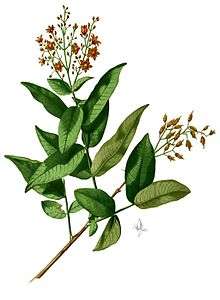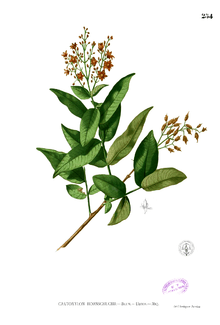Cratoxylum
Cratoxylum (or Cratoxylon Blume, an orthographic variant) is a genus of flowering plants in the family Hypericaceae, native to tropical Asia. The generic name is from the Greek meaning "strong wood", referring to the timber.[2]
| Cratoxylum | |
|---|---|
 | |
| Cratoxylum sumatranum | |
| Scientific classification | |
| Kingdom: | Plantae |
| Clade: | Tracheophytes |
| Clade: | Angiosperms |
| Clade: | Eudicots |
| Clade: | Rosids |
| Order: | Malpighiales |
| Family: | Hypericaceae |
| Tribe: | Cratoxyleae |
| Genus: | Cratoxylum Blume[1] |
| Species | |
|
See text | |
Description
Cratoxylum species grow as shrubs or small to medium-sized trees. The bark, drying black, produces a yellow resinous sap. The flowers are white or pink to crimson. The ellipsoid fruits consist of three valves.[2]
Distribution and habitat
Cratoxylum species grow naturally from India through southern China to Malesia.[2]
Species
As of May 2014 The Plant List recognises 9 accepted taxa (of species and infraspecific names):[3]
- C. arborescens (Vahl) Blume
- C. cochinchinense (Lour.) Blume
- C. formosum (Jacq.) Benth. & Hook.f. ex Dyer
- C. glaucum Korth.
- C. maingayi Dyer
- C. sumatranum (Jack) Blume
gollark: Wait, what's that on the URL?
gollark: 110 in Halloween? STILL?
gollark: Because some people can't get Halloween stuff?
gollark: Is it likely that the ridiculously busy Halloween biome will become actually usable soon?
gollark: The 5 min drops.
References
- "Genus: Cratoxylum Blume". Germplasm Resources Information Network. United States Department of Agriculture. 2 April 2006. Archived from the original on 31 May 2014. Retrieved 29 May 2014.
- Wong, K. M. (1995). "Cratoxylum Blume". In Soepadmo, E.; Wong, K. M. (eds.). Tree Flora of Sabah and Sarawak. (free online from the publisher, lesser resolution scan PDF versions). 1. Forest Research Institute Malaysia. pp. 220–226. ISBN 983-9592-34-3. Archived from the original (PDF) on 27 September 2013. Retrieved 29 May 2014.
- "Cratoxylum". The Plant List. Retrieved 29 May 2014.
This article is issued from Wikipedia. The text is licensed under Creative Commons - Attribution - Sharealike. Additional terms may apply for the media files.
